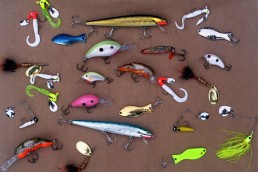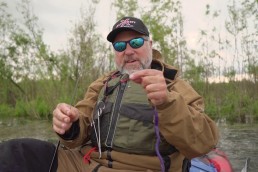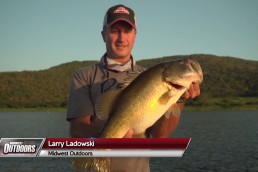Think ‘Small’ for Bass
SHARE THIS POST
Some bass fishermen have the misconception that only big lures catch big bass. This is actually a common-sense attitude that is often proven wrong by bluegill and crappie fishermen.
Missouri lakes in April are filled with bass gorging themselves on minnows, shad, crawfish, and occasional baby duck and any snakes that happen by. In other words, they are feeling “frisky” because of warming water temperatures and are hungry.
Largemouth bass by nature love an easy meal. And a suspended minnow is either hurt or too dumb to remain in the food chain. Big bass look for easy offerings that are just waiting to be devoured. Suspended crappie lures or minnows look like that easy meal. Small lures can catch big bass and crappie fishermen occasionally hook a largemouth on jigs. In fact, I caught a 6-pound pre-spawn female on a white Roadrunner this spring.
But have you ever wondered why a big bass would eat our equivalent of a small snack?
“Bass are opportunistic predators,” says Gene Gilliland, Central Region Fisheries supervisor for the Oklahoma Department of Wildlife Conservation. “Small baits are often attractive to a bass, no matter how big the bass is. Largemouths especially often focus in on certain size bait that is available. For example, if 3,000 2-inch minnows are around, they may feed only on that particular size no matter what swims in front of their face.”
Gilliland found that schooling bass chasing shad on the surface become very particular about size. They may pass on a 3-inch shad for a 2-inch shad. The angler must figure out the preferred size that day. Two- to 3- inch shad tends to be the optimum size for most bass.
“The smaller lures are effective because the current hatch of shad is small down here at Reelfoot,” said Billy Blakely, Blue Bank Resort’s top bass guide on Reelfoot. “We had a late hatch of baitfish creating a great time to use small baits.”
Smaller balsa minnows like the floating Rebel have been one of my best lures throughout thick cover in warm weather. I have caught large bass by tossing the minnow imitation around the edges of weed beds, moss, boat docks, logs, stumps or any cover where bass may wait for an easy meal.
I have watched a wounded bluegill or shad flip on the surface until a bass crushed it with a deadly attack. That is exactly how largemouth slam floating balsa lures—with a vengeance.
Spinners are my first choice. Mepps and Roostertail spinners are excellent for catching bass. A constant flashing through the water is often interrupted by a vicious strike. I prefer a number 2 Mepps with gold blade and brown bucktail or the smallest Roostertails available. I have caught many big bass on this type of spinner. Work spinners as slow as possible while staying out of the moss and still making the spinner turn.
Jigs
Crappie jigs, beetle spins and Road Runners are imitations of minnows and highly effective. They are generally retrieved slowly with an occasional twitch to make them jump. Pauses are good and will often draw strikes. The key is to make the jig look like a live minnow.
Small bobbers are often attached 1 or 2 feet above feathered or plastic jigs, especially when a pond has heavy moss. Then use a steady retrieve slowly in waves and quicker in calm waters. You can expect to catch almost anything on a jig. I occasionally attach another jig by tying a small leader to the first jig. This gives fish the idea of two minnows or perhaps a small school passing by. Feeding frenzies have been started over passing minnow schools.
Weather and small baits
“Weather makes changes in natural settings like a lake or pond,” Gilliland says. “Weather changes affect everything through the entire food chain, from plankton to bass. Bass adjust to these changes by finding new feeding patterns. Colder water slows down bass metabolism. The need for calories is reduced. Small, easy meals become important. Smaller meals when the water is cold might be more attractive to bass.”
Are you enjoying this post?
You can be among the first to get the latest info on where to go, what to use and how to use it!
Gilliland adds that heavy rain often makes bass feed in different areas. Then they may zone in on what is most available. Murky water in weed beds may push them out to find more clouds of the smaller shad, meaning that smaller baits become more effective.
Murky water may change light penetration to make them roam outside edges of weed beds, as Matt and I discovered. Bass gain a predator’s advantage to finding food in open water and shad too may have been pushed out into the open.
Plastic worms
Carolina rigging, Texas rigging, do-nothing worms or Shaky Head worms are absolutely fantastic in April on Missouri lakes and ponds or Ozark streams. I seldom go bigger with a 6-inch worm. Colors are up to you, but purple is my most consistent.
I use little or no weight on smaller lakes or ponds. This allows the worm to drop naturally, and in April bass love to hit on the drop. Pressure is often felt on the rod lift. And crawling a worm slowly is a hot ticket in the spring.
Small baits in bass tournaments
My close friend who is no longer with us, Roger Moore, was one of the first to fish B.A.S.S. Tournaments with light tackle. He only used light- to medium-action rods.
He once explained, “I give bass an easy meal,” he said. “They don’t have to attack a big spinner bait or crankbait, just a morsel. I present my lures on lighter line; I think that makes a difference. Many of my competitors use 20- to 30-pound-test while I prefer 6- to 10-pound-test. This is especially good in clear water. I catch a lot of fish that barely measure in tournament weigh-ins and occasionally a bigger one too.”
Moore set a record for catching bass while using Garcia Mitchell 309 and 409 ultra-light spinning reels in the 1970s. Most in those days used Ambassador 5000 baitcasting reels on cue-stick rods or the equivalent.
“I never got skunked my first four years of fishing B.A.S.S., including four B.A.S.S. Masters Classics,” Moore recalls. “That’s 108 straight fishing days without drawing a blank. I credit 90 percent of that success to fishing light tackle.”
Moore found that catching “point fish” served him better than hunting for larger bass. He did manage to catch a few big bass, and, of course, he lost a few, but he qualified for the Classic most years. He simply got twice as many strikes.
“If you don’t have the confidence to fish smaller lures in a tournament, you should at least fish light tackle during pre-fishing days to help determine bass patterns,” Moore said. “After all, it is well known that you will always get more strikes on lighter tackle and smaller lures than on heavier tackle and larger lures.”
I am not saying that you should drop big lures for the smaller version. But I am saying that smaller baits for bass should be part of your arsenal. Include a box of what may seem like panfish baits, and you may save what could have been an unproductive day.
Kenneth L. Kieser is an award-winning writer of 38-plus years who is a member of the National Fresh Water Fishing Hall of Fame and Waterfowler’s Hall of Fame as a Legendary Communicator. Also named 2014 Conservation Communicator of the Year by Missouri Conservation Federation, we are excited to welcome his voice to MidWest Outdoors.
MWO
SHARE THIS POST
Did you enjoy this post?
You can be among the first to get the latest info on where to go, what to use and how to use it!
Kenneth L. Kieser
Kenneth L. Kieser is an award-winning writer of 38-plus years who is a member of the National Fresh Water Fishing Hall of Fame and Waterfowler’s Hall of Fame as a Legendary Communicator. Also named 2014 Conservation Communicator of the Year by Missouri Conservation Federation, we are excited to welcome his voice to MidWest Outdoors.



